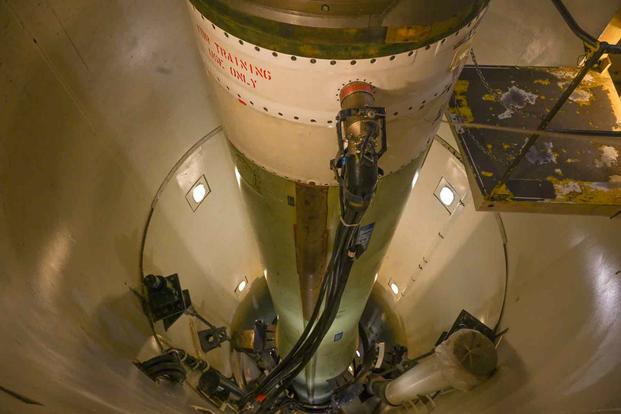This story, part of a series of reporting projects by Military.com on service member and veteran health, was supported by the Pulitzer Center. You can read our first story on missileer cancer concerns here and our second story on maintainers' health worries here.
Missileers will soon have workplace exposures and hazards added to their records, and there will be more inspections of the underground bunkers where they work, a major reform as the service continues to investigate growing cancer concerns within the career field.
During a Thursday town hall hosted by Air Force Global Strike Command, which was open to the public, service officials announced that, by December, missileers will have their information submitted to the Defense Occupational and Environmental Health Readiness System, or DOEHRS -- a Pentagon database for reporting occupational and exposure hazards while on the job.
Missileers, the service members who are stationed 60 feet underground to watch over and potentially fire America's nuclear missiles, were considered for decades to have an administrative job. But, as detailed in a Military.com investigation, those officers have been exposed to widespread carcinogens and toxic dangers in the Cold War-era launch control centers where they live and work for days at a time.
Read Next: Military Services Approving Roughly 3% of Malpractice Claims from Service Members
"We're in the process of adding missileers to this system (DOEHRS)," Lt. Col. John Severns, a spokesperson for Air Force Global Strike Command, said Friday. "This info from DOEHRS flows into the recently developed Individual Longitudinal Exposure Record (ILER), a system that compiles occupational and environmental health data throughout a person's career."
DOEHRS, a system that has tracked Air Force records since 2010, will allow any of those workplace or environmental incidents to be accessed by Defense Department and Department of Veterans Affairs medical staff. It will be available for individuals to access by 2025, Severns said.
Severns added that "health risk assessments are underway now" for missileers.
Meanwhile, nuclear missile maintainers, the enlisted service members who are responsible for fixing the intercontinental ballistic missiles, have for years been subjected to thorough occupational site visits in the launch facilities where they work and -- as Military.com reported in a recent investigation -- been exposed to a wide variety of dangerous chemicals and carcinogens.
But missileers were not subject to the same level of scrutiny in the launch control centers where they worked, despite well-documented risks of exposure to substances such as polychlorinated biphenyls, or PCBs, highly carcinogenic chemicals that have recently been detected in some areas of those bunkers at bases.
Launch control centers will now undergo similar workplace investigations as those done at the launch facilities where maintainers work.
"So, while our maintainers may have had operational site visits, we did not perform those visits with the missile officers, and that will change going forward," Col. Tory Woodard, the commander of the Air Force School of Aerospace Medicine, said during the town hall. "Our efforts will standardize occupational health reporting and analysis going forward. Overall, our goal is to make sure we are protecting today's airmen."
Severns said those site visits should be completed by December.
Air Force Global Strike Command's changes and public town hall came in the wake of two Military.com investigative reports detailing the health struggles that generations of missileers and nuclear missile maintainers have had and believe are connected to exposures on the job.
Officials said Thursday that site visits and testing has been done at F.E. Warren Air Force Base in Wyoming, Malmstrom Air Force Base in Montana, and Minot Air Force Base in North Dakota, as well as Vandenberg Space Force Base in California.
So far, the only substance detected above the Environmental Protection Agency's threshold has been PCBs at two of the bases -- Malmstrom and Minot.
But the launch facilities, the underground silos where the actual missiles themselves are kept, at the three operational bases -- F.E. Warren, Malmstrom and Minot -- have not yet been tested for contaminants. Air Force Global Strike Command officials announced Thursday that those will now undergo testing starting in July. More findings from past environmental tests are set to be released this summer.
In addition to the environmental testing, the Air Force is currently undergoing a wide-ranging health study looking at multiple generations of missileers, maintainers and other support staff who worked with intercontinental ballistic missiles to look for health trends.
Early results indicate some elevated cancer levels, but Air Force Global Strike Command still needs data from Department of Veterans Affairs medical records, the DoD cancer registry, and the VA cancer registry for a more complete picture.
Those next findings should be shared in September, as officials probe records dating back to the mid- to late-1970s and, eventually, state and national cancer data, too.
Dozens of former missileers, maintainers and family members of deceased service members joined Thursday's town hall to ask about the status of the study, raise concerns over whether they were exposed, and detail their fight for VA benefits.
Dan Holmes, a former missileer and the father of Mark Holmes -- a missileer stationed at Malmstrom who died from non-Hodgkin lymphoma -- asked officials about when his son's family could eventually receive death benefits and when the VA would acknowledge the diagnoses seen among the missile community.
"Is it going to take many more years for these studies to be conducted before the VA will come on board and recognize that my son's death and many others [were] service-related?" Dan Holmes asked officials. "Which [it seems] to be impossible to convince them of that fact."
Related: Unprotected: Troops Spent Decades Elbow-Deep in Dangerous Chemicals to Keep Nuclear Missiles Working












